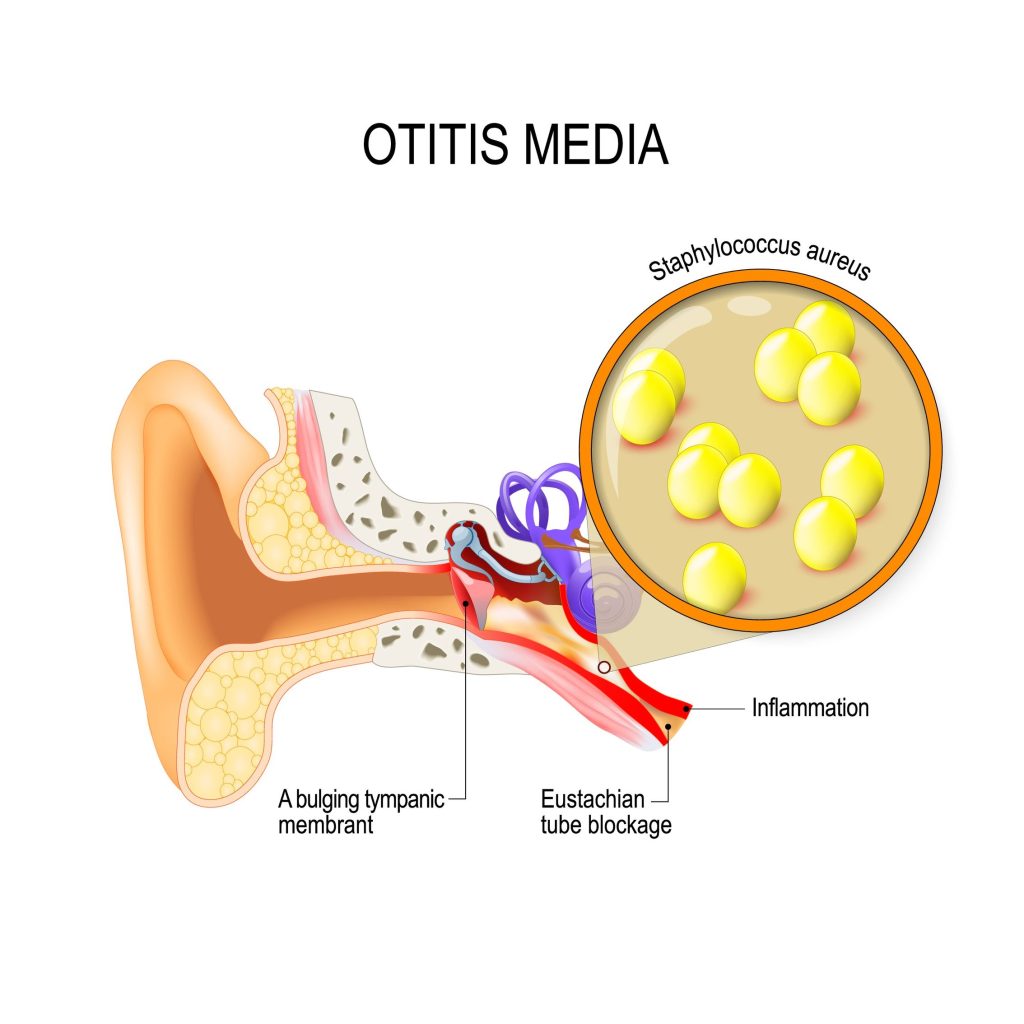Mark Kopec Now
Ear Infection
Ear Infections: Causes, Diagnosis, Treatment, and Legal Rights from Baltimore Ear Infection Lawyer Mark Kopec
Ear infections are a common ailment, particularly among children. They can be quite unpleasant, causing pain, fever, and also hearing problems. But what exactly are ear infections, and how do they occur? This webpage delves into the anatomy of the ear, explores the different types of ear infections, and then explains how they are diagnosed, treated, and the potential risks if left untreated. If you have an injury from a misdiagnosis of an ear infection, then you may have a medical malpractice claim. Contact Baltimore ear infection lawyer Mark Kopec at the Kopec Law Firm.
Ear Anatomy
The ear is a marvel of engineering, responsible for our sense of hearing and balance. It can be broadly divided specifically into three sections: the outer ear, the middle ear, and the inner ear.
- Outer Ear: This visible part consists of the pinna (the fleshy part), the ear canal, and also the eardrum. The ear canal collects sound waves and channels them towards the eardrum, a thin membrane that vibrates in response to the incoming sound.
- Middle Ear: An air-filled cavity located behind the eardrum. It houses three tiny bones: the malleus, incus, and stapes. These bones specifically work together to transmit vibrations from the eardrum to the inner ear.
- Inner Ear: This intricate structure contains the cochlea, which is responsible for converting sound vibrations into electrical signals interpreted by the brain as sound. The inner ear also houses the vestibular system, which plays a crucial role in maintaining balance.
Preventing Ear Infections
Several measures can help reduce the risk of ear infections and the need to consult with the ear infection lawyer:
- Frequent Handwashing: This is a simple yet effective way to prevent the spread of germs that can cause ear infections.
- Minimize Secondhand Smoke Exposure: Exposure to secondhand smoke irritates the Eustachian tubes and increases the risk of ear infections.
- Breastfeeding: Breast milk provides antibodies that can help boost an infant’s immune system and protect them from ear infections.
- Vaccinations: Vaccinating children against common respiratory illnesses like influenza and pneumococcus can help reduce the risk of ear infections caused by these viruses and bacteria.
- Minimize Pacifier Use: While pacifiers can be soothing for babies, prolonged use, especially while lying flat, might increase the risk of ear infections by allowing fluid to pool in the Eustachian tubes.
Types of Ear Infections
There are two main types of ear infections, each affecting different parts of the ear:
- Otitis Media (Middle Ear Infection): This is the most common type of ear infection, particularly in children. It occurs when the Eustachian tube, a tube that connects the middle ear to the back of the throat, becomes blocked. This blockage traps fluid behind the eardrum, creating a breeding ground for bacteria or viruses.
- Otitis Externa (Swimmer’s Ear): This infection affects the outer ear canal, often caused by trapped water after swimming or exposure to moisture. It can also be caused by scratching or irritating the ear canal with cotton swabs or other objects.
Baltimore ear infection lawyer Mark Kopec at the Kopec Law Firm can review the specific infection that you had.

Who to See for an Ear Infection
If you suspect an ear infection, it’s crucial to see a doctor for proper diagnosis and treatment.
- For Adults and Children: A general practitioner or pediatrician can diagnose and treat most uncomplicated ear infections.
- For Infants and Young Children: A pediatrician is best suited to examine and treat ear infections in young children, as they have the expertise to handle their specific needs.
- For Persistent or Complex Cases: In some cases, an ear, nose, and throat (ENT) specialist, also known as an otolaryngologist, may be needed for further evaluation and treatment, particularly for recurrent or chronic infections.
Diagnosis of Ear Infections
Doctors typically diagnose ear infections through a physical examination. They may use a special instrument called an otoscope to examine the ear canal and eardrum. In some cases, they might also perform a pneumatic otoscopy, a painless procedure that puffs air into the ear canal to assess the mobility of the eardrum.
For infants and young children who may not be able to verbalize their symptoms, a doctor’s observation of their behavior and signs like ear pulling can be significant clues in diagnosing an ear infection.
Treatment of Ear Infections
The treatment for an ear infection depends on the type and severity of the infection.
- Middle Ear Infection (Otitis Media):
- Pain Relief: Over-the-counter pain relievers like acetaminophen or ibuprofen can help manage discomfort.
- Antibiotics: In most cases, antibiotics are prescribed to eradicate the bacterial infection. However, for mild infections caused by viruses, antibiotics may not be necessary, as the body’s immune system usually clears the virus on its own.
- Decongestants: Nasal decongestants or saline nasal sprays can help clear congestion in the Eustachian tubes, promoting drainage and easing discomfort.
- Swimmer’s Ear (Otitis Externa):
- Ear Drops: Antibiotic or corticosteroid ear drops are typically prescribed to combat the infection and reduce inflammation.
- Pain Relief: Similar to middle ear infections, pain relievers can help manage discomfort.
- Drying the Ear Canal: It’s crucial to keep the ear canal dry to prevent further irritation and promote healing.
Baltimore ear infection lawyer Mark Kopec at the Kopec Law Firm can assess whether you timely received the appropriate treatment for your ear infection.
Bad Outcomes & the Need for Baltimore Ear Infection Lawyer Mark Kopec
While most ear infections clear up on their own or with treatment, a delay in diagnosis or treatment can lead to serious complications.
- Hearing Loss: Untreated middle ear infections can damage the delicate bones in the middle ear, potentially leading to permanent hearing loss.
- Speech Delays: In children, recurrent ear infections can hinder speech and language development.
- Mastoiditis.: This is an infection of the mastoid bone, located behind the ear. Symptoms include severe ear pain, swelling behind the ear, and fever. Mastoiditis can be a serious complication of untreated middle ear infections and requires immediate medical attention.
- Meningitis: In rare cases, an untreated ear infection can also spread to the meninges, the protective membranes surrounding the brain and spinal cord. This is a life-threatening condition that requires prompt hospitalization and intravenous antibiotics.
Baltimore ear infection lawyer Mark Kopec at the Kopec Law Firm can assess the damages that you received from your ear infection.
Ear infections are a common health concern, particularly for children. However, with proper diagnosis and treatment, most ear infections resolve without complications. It’s also important to remember that early intervention is key. If you suspect an ear infection in yourself or your child, consulting a doctor promptly ensures a swift recovery and minimizes the risk of potential complications. By understanding the different types of ear infections, their causes, treatment options, and preventative measures, you can play a proactive role in safeguarding your ear health and well-being.
Next Step: Contact the Baltimore Ear Infection Lawyer
If there was a misdiagnosis of your ear infection and you injured, then visit our free consultation page or video. Then contact the Kopec Law Firm at 800-604-0704 to speak directly with Attorney Mark Kopec. He is a top-rated Baltimore medical malpractice lawyer. The Kopec Law Firm is in Baltimore and pursues cases throughout Maryland and Washington, D.C.





